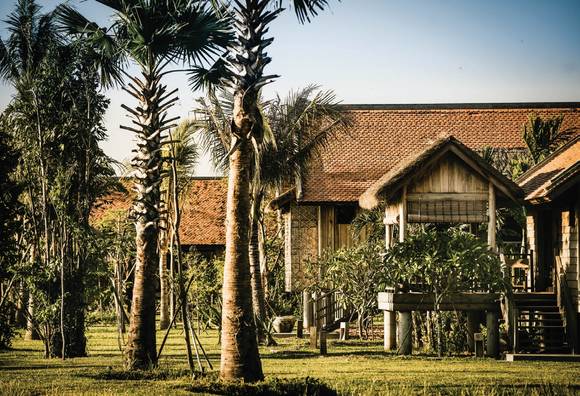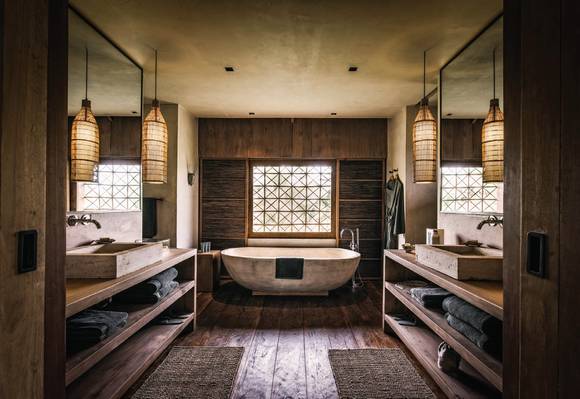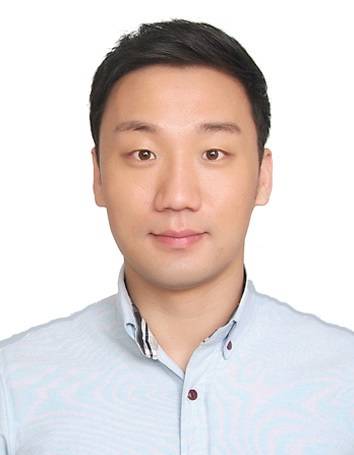[임준환(JIMI LIM)의 Hotel Design Story]“Neither trend nor strategy”
2016.06.24 10:38:07
Phum Baitang by Zannier Hotels Sangkat Svaydangkum, Siem Reap, Cambodia


“Neither trend nor strategy”(트렌드를 따르지 않고 전략을 만들지 않겠다.) 이는 2016년 The Asia Hotel Design Awards 디자인 부문에서 아시아 최고의 호텔로 선정된 품바이탕(Phum Baitang) 리조트를 설계한 회사, 재니어 호텔(Zannier Hotels)의 경영 철학이다. 시시각각 변하는 소비자의 트렌드에 발맞춰 새롭고 획기적인 전략을 세워야 할 호텔에서 이 두 가지를 따르지 않겠다니... 글쓴이 또한 이 문장의 의미를 잘못 해석한 것이 아닐까 몇 번을 재확인하다 그 뒤에 위대한 철학가의 사상이 뒷받침돼 있다는 것을 깨달았다.
“Simplicity is the ultimate sophistication.”(단순함은 궁극의 정교함이다.) 르네상스 시대의 이탈리아를 대표하는 천재적 미술가이자 과학자·기술자·사상가였던 레오나르도 다빈치의 명언이다. 즉, 과학, 철학, 의학, 수학, 물리학, 건축학 등에서 도저히 풀리지 않는 부분이 있다면 모든 가설들 중에 가장 믿을만한 키 포인트만 남기고 그 가설을 중심으로 단순화하면 의외로 쉽게 해답을 찾을 수 있다는 개인적 경험과 사물의 실재에서 깨달은 엄청난 의미와 철학이 숨겨진 이 명언의 의미를 재니어는 제대로 이해하고 그 안에서 해답을 찾은 것이다. 이처럼 레오나르도의 철학은 재니어 호텔 건축 & 디자인팀의 인테리어 디자인과 디테일 그리고 건축적인 요소를 결정하는데 중요한 토대가 됐다.
일반적인 디자이너들은 보통 1992년 유네스코 세계문화 유산으로 등재된 크메르제국 시대의 ‘앙코르와트(Angkor Wat) 사원’을 비롯한 ‘앙코르 톰(Angkor Thom)’의 양식을 현대적으로 재해석하거나, 박물관에 전시된 시대적 양식들을 재해석하며 마블 스톤과 번쩍이는 철제 및 유리 재료들로 구성하는 등, 무한히 많은 건축 및 디자인적 요소들을 연구하고 알맞게 적용하는데 재니어 호텔 건축 & 디자인팀은 오직 자연을 배경으로 캄보디아의 자연의 아름다움에 그들조차도 매료돼 그 안에서 자연적 재료들을 찾아 너무나도 서민적이며 서정적인 요소 그대로를 호텔에 담아냈다.
프랑스 출신의 설립자, Arnaud Zannier와 젊은 전문가들로 구성된 재니어 건축 & 디자인팀은 허세와 가식을 떠나 호텔이 지어진 자연 그대로의 환경을 느끼게 하며 젊은이에서부터 노인, 가족과 커플 또한 싱글 탐험가 등 누구나 꿈꾸는 이상적인 럭셔리 호텔의 경험을 제공 하려 한다. 그들은 2011년 프랑스 알프스산맥 산속 깊이 위치한 마을에 12개의 방으로 구성된 호텔 Le Chalet Zannier를 시작으로 캄보디아 시엠립 변두리에 위치한 45개의 프라이빗 룸들로 구성된 품바이탕에 이어 지금도 세계 곳곳에 가능한 장소들을 찾고 있다.
앞서 말했듯이 품바이탕 호텔은 2016년 The Asia Hotel Design Awards에서 리조트부분 올해의 건축상과 인테리어 디자인 부분에서 바와 스파, 그리고 최종적으로 올해의 호텔 디자인상을 포함 총 4관왕을 차지했다. 특히 심사위원들은 소박함과 풍부함의 아름다운 결합, 지역 고유 특성을 반영한 건축물, 각 공간들의 수제품들과 정교하면서도 세련되며 품위가 느껴지는 인테리어 공간이라 극찬했다.
크메르어로 녹색마을(Green Village)인 품바이탕은 레몬글라스 농장 사이에 위치한 캄보디안 집들을 닮았고, 캄보디아 현지 건축의 아름다움을 그대로 반영하며 고객에게 쾌적하고 풍부한 경험을 할 수 있도록 설계됐다. 건축가는 현지 스타일을 카피하며 무언가를 창조하는 것을 회피하는 동시에 고객에게 최대한 사실적인 표현을 제공하기 위해 꾸준히 연구해왔다.
먼저 종합계획부터 실내계획에 이르기까지 날씨와 환경적 요소들이나 지역적인 관습 등 그 지방 특유의 정보들을 이해하는 것은 건축 기술에 큰 영향을 끼친다. 맞배 지붕과 건물의 지주, 건물의 배치 및 구성은 현지 마을과 비슷한 양식으로 적용됐고, 아웃도어 리빙(outdoor living) 콘셉트로 전통 건축물의 외부발코니는 고객의 편의에 맞게 발전 및 적용됐다. 바에서는 주변이 논으로 펼쳐진 스펙타클한 석양의 아름다움을 만끽할 수 있다. 이처럼 이 호텔을 위한 디자인 포커스는 자연에 대한 본질적인 요소들이다, 불필요한 데코레이션을 배재한 자연적인 재료들, 나무, 돌, 대나무, 지붕을 이기 위해 짚으로 엮은 이엉 등을 최대한 사용했으며, 이러한 것들은 심미적으로 없어서는 안 될 구성 요소가 됐다. 또한 골동품과 가공되지 않은 본래의 재료로 만들어진 예술 작품들은 과거부터 현재로의 시간적인 흐름을 느낄 수 있는 동시에 실내의 따뜻한 느낌 및 고귀한 아름다움을 고객에게 선사한다.
캄보디아 유네스코 유산 앙코르와트에서의 첫 일출을 보기 위해 이른 새벽부터 일정을 시작해 살인적인 스케줄에 지친 고객에게 편안한 마음을 갖게 하고 충분히 충전할 수 있는 기회를 제공하고 현지 요리수업과 게임과 퍼즐을 통해 캄보디안의 문화를 체험하는 등 마치 자신들이 고객의 입장이 돼 그들이 느끼게 될 특별한 공간을 창조했고, 이러한 내부 공간들은 친숙하고 아늑한 마치 집에 머무는 듯한 느낌을 들게 한다.
마지막으로 독자의 이해를 돕기 위해 캄보디아의 주거 형태에 대해 알아봤다. 캄보디아 주택의 형태는 플랫하우스와 빌라가 주를 이루고 있지만 아파트들이 점차 늘어나면서 아파트의 장점을 알게 된 캄보디아인들의 인식이 점차 변해가고 있는 추세다. 아파트는 대규모보다는 7층 정도 높이의 건물로 지하는 없고 1층에 주차장을 배치하며 2층부터 주거단지로 만든 것들이 대부분으로 거의 외국인들이 임대해서 거주하고 있다. 빌라는 캄보디아식 빌라와 프랑스식 빌라 등 여러 형태로 나뉘어 있고, 외관상 크게 다르다기보다는 건축양식에 조금씩 차이가 있다.
플랫하우스는 가로 4~5m, 세로 15~20m의 직사각형 형태로 도로에 접한 작은 형태의 주택이며 캄보디아 대다수 국민들이 기거하고 있다. 프랑스풍의 주택이라 하며 대개 3~4층으로 이뤄져 있고 층마다 낮은 복 층으로 이루어져 전체는 6~8층 정도 되는 건물로 방의 수가 많은 것이 특징이다. 이외에 강가나 개울가에 물 위에 지어진 수상가옥들을 많이 볼 수 있다.
전통가옥은 프놈펜 시내에서는 거의 찾아보기 힘들고 변두리나 시골에 가면 쉽게 볼 수 있다. 네 개의 기둥으로 받쳐진 2층 구조로 되어 있으며, 1층은 주로 평상 같은 것을 놓고 쉼터로 많이 이용하고 있으며, 가축을 키우는 집들도 가끔 있다. 주로 2층에서 생활하는데 집의 크기에 따라 방이 1~2개 정도 된다. 전통가옥도 재산 상태에 따라 벽돌집이나 나무판자로 집을 짓고, 가난한 사람들은 나뭇잎으로 집을 짓는다. 1층은 쏟아지는 폭우에 침수가 쉽게 되고, 뱀 같은 동물들이 많으며, 2층보다 덥기 때문에 비용이 많이 들더라도 2층 집을 짓는다.
매년 수많은 호텔들이 끊임없이 변화하는 민감한 트렌드에 반응하고 자신들의 브랜드를 위해 무언가를 전달하며 생기고 발전한다. 이에 반해 재니어 호텔은 건축적으로 깊은 인상을 주거나 놀라운 것보다 고객이 느끼게 될 그 순간에 집중했다. 그들이 추구하는 소박하며 자극적이고 혁신적인, 세상에서 가장 유일한 디자인, 그건 바로 자연이 아닐까 싶다. 인간이흉내낼 수 없는 대자연의 아름다움을 마음껏 누려 보라.
이미지 제공_ Zannier Hotels
It is the management philosophy of Zannier Hotels, the company that designed Phum Baitang resort selected as the top Asian hotel in terms of design at The Asia Hotel Design Awards 2016. In step with the ever-changing consumer trend, hotels a re supposed to follow the two based on new and innovative strategies. However, the company announced not to follow trend and strategy. The writer of this article, too, had to check the sentence over and over again to see if I misinterpreted its meaning. But then, I found the profound support of a great philosopher therein.
“Simplicity is the ultimate sophistication”, the sentence is a wise saying by Leonardo da Vinci, the genius artist, scientist, technician and thinker representing Italia in the Renaissance period. It means the essence of individual experience and realization acquired from the existence of objects that if there is any deepest mystery in science, philosophy, medicine, mathematics, physics and architecture, just leave the most reliable key points in all of the hypotheses and simplify by centering on the remaining hypotheses. Then one can get an answer easier than expected. Zannier properly saw such a huge significance and profound philosophy hidden in the saying and found an answer therein. Leonardo’s philosophy, as shown in the case, serves as an important foundation for Zannier to determine its interior design, details and architectural factors.
Concerning the 5-star hotels for travelers, lots of numerous architectural and design factors are researched and applied appropriately. For instance, designers are normally tasked with the modern-style reinterpretation of Angkor Thom and Angkor Wat during the Khmerm Empire, which were registered with the UNESCO as World Heritage in 1992; or reinterpretation of styles of each period exhibited in museums to structure with materials such as marbled stones, shiny steels and glasses. The architecture & design team of Zannier Hotels, however, already charmed by the beauty of nature in Cambodia themselves, utilized solely nature as their background along with natural materials therein to add deeply folksy and lyrical atmosphere to their work.
The Zannier architecture & design team consisted of experts including the French founder, Arnaud Zannier, stripped off any show or fake to let people feel the natural environment of their hotel as it is. They try to provide the ideal luxury hotel ex perience everyone dreams of from young people to senior people, families, couples and single explorers. Starting from Hotel Le Chalet Zannier with 12 rooms deep into the Alps, France, in2011, they built Phum Baitang having 45 private rooms in the suburbs of Siem Reap, Cambodia and are searching for good places around the world for their business.
As mentioned above, Phum Baitang Hotel was awarded in 4 areas – architecture of the year in the resort area, bar and spa in the interior design area; and the hotel of year at The Asia Hotel Design Awards 2016. The juries, in particular, highly praised the hotel, saying that it was the beautiful combination of modesty and richness, an architectural structure reflecting unique local characteristics, with so phisticated, delicate and graceful interior space along with the handmade articles in each space.
Phum Baitang, In the Khmer language, means green village. It resembles the Cambodian houses located between lemon grass farms. It was designed by reflecting uncompromised beauty of Cambodian local structures in order to provide pleasant and rich experience to customers. The architect tried to avoid creating something by copying the local style and, at the same time, steadily continued research with a view to provide the maximum possible realistic expression to customers.
First of all, from the general plan to interior plan, to understand specific local information has a huge impact to architectural technique such as weather, environmental factors and local customs. The gable roof, building pillar, building placement and composition were similar to those in local villages. Under the conceptual idea of outdoor living, the external balconies of traditional structures were developed and applied in line with customer convenience. At the bar, visitors can enjoy the spectacle beauty of sunset unfolded over the surrounding rice field. As such, the design focus for this hotel is the essential factors of nature. Natural materials such as tree, stone, bamboo tree, and straw thatch for the roofing without unnecessary decorations were utilized to the maximum level. And they became in dispensable components aesthetically. Also the antiques and works of art made of unprocessed nat ural raw materials let viewers feel the passage of time from the past and, at the same time, warmth inside and noble beauty.
For any customer who had to start the schedule early in the morning to see the first sunrise at the World Heritage, Angkor Wat, and follow busy tour schedule, the hotel can successfully provide opportunities to regain inner comfort and fully recharge. While experiencing Cambodian culture through local cooking class, games and puzzles, the design team studied customers’ perspective to create special place for customers to truly engage and feel. Such internal spaces make visitors feel the familiarity and coziness like home.
Lastly, the housing pattern of Cambodia was examined. In Cambodia, flat houses and villas account for the dominant part. Still the number of apartment houses is growing as more Cambodians are aware of the strong points of apartment complex. Apartment buildings tend to be about 7-story buildings and not in a large-scale complex. They have no underground floor and have a parking lot in the 1st floor and residential places from the 2nd floor. Mostly, they are leased to foreign residents.
Villas are divided into diverse types including Cambodian-style villa and French-style villa. They are not far different in terms of the exterior but have a little difference in architectural styles.
Flat house is 15~20m x 4~5m-sized smaller rectangular residential places along the street. Most of
the Cambodian population live in flat houses. They are called French-style housing mostly in 3~4 floors and each floor is low-rising two-storied to make the total height as 6~8 floor buildings. Flat houses are characterized to have many rooms. In addition to these, there are lots of floating houses built on rivers or streams.
Traditional houses are hardly found in the downtown Phnom Penh but easily found in suburban or rural areas. They are two-storied structure supported by 4 pillars. The 1st floor is normally utilized as a rest area with low wooden benches or some keep livestock therein. People usually live in the 2nd floor. Depending upon the size of house, there are 1~2 rooms. According to one wealth, some build traditional house with bricks or wood board and poorer ones build with tree leaves. The 1st floor is easily flooded by heavy rain, infringed by many animals like snake and warmer than the 2nd floor.
Thus, people build two-storied houses despite larger cost.
Every year, numerous hotels react the ever-changing sensitive trend. They are created and developed to communicate something for their brand names. On the other hand, Zainner Hotel focused on the moment that customers can actually feel the natural environment ratherthan trying to impress or surprise the min any architectural manner. The modest still simulative,
innovative and the only unique design in the world may be nature as sought after by them. Now,
be ready to enjoy the beauty of mother nature that no human can imitate.
Images by Zannier Hotels

임준환
Wilson Associates, 디자이너
영국 런던예술대학원(University Art of London)에서 공간디자인으로 석사 학위를 받고, 현재 Wilson Associates의 Associate 디자이너로서, 세계 각지의 리조트, 호텔 & 카지노디자인 디벨롭먼트 부분을 담당하고 있다. 영국 런던 한인 예술인 협회에 소속 작가로 활동 하였으며, 예술과 디자인에 관련해 영국 및 싱가포르에 거주하며 이슈 작가 작품을 한국에 알리는 글을 써 왔다,
JIMI LIM
Wilson Associates, Designer
Jimi Lim, the writer of this article, received the Master’s degree of spatial design from the University Art of London and presently serves as the Associate Designer at Wilson Associates, managing the design development of resorts, hotels and casinos over the world. He works as an Artist at the Korean Artists’ Association in London, UK and has written about rising artists and art works concerning art and design to let the Koreans know more about them as he has stayed in the UK and Singapore.
- 2024.11.05(화)~2024.11.11(월) 투어리즘&마이스 서울특별시관광협회, 제27대 협회장 후보자 등록 실시
- 2024.10.25(금)~2024.11.07(목) 대회·공모전 "서울 관광산업 발전에 기여한 자를 찾습니다."…서울특별시관광협회(STA), 2024 서울관광대상 수상 후보자 모집
- 2024.10.18(금)~2024.10.19(토) 축제 한국관광공사, 원주 시민과 함께하는 ‘세계로(路) 페스타’개최
- 2024.10.13(일)~2024.10.20(일) 축제 하슬라국제예술제 오는 13일 개막… 공연장으로 탈바꿈한 강릉 정체성 담긴 장소들
- 2024.10.5(토)~2024.11.3(일) 축제 대한민국 대표 공연관광 축제 ‘2024 웰컴대학로’ 개최
-

[HOTEL+DINING PROPOSAL] 화려함을 뽐내는 호텔의 크리스마스 케이크
- 2024-11-28
- 서현진 기자
-

영풍항공여행사 조태숙 대표, 서울특별시관광협회 27대 협회장 당선
- 2024-11-27
- 서현진 기자
-

전국 대학생들이 제안한 안동 관광 활성화 아이디어를 겨루다
- 2024-11-27
- 서현진 기자
-

마리아나관광청, 오는 12월 20일부터 부산-사이판 전세기 운항
- 2024-11-27
- 호텔앤레스토랑
-

이랜드파크 켄싱턴호텔 여의도, 스시&그릴 라이브 다이닝 ‘브로드웨이’ 크리스마스 및 연말 맞이 ‘페스티브 프로모션’ 선봬
- 2024-11-27
- 안수진 기자
-

파라스파라 서울, 프리미엄 사우나 라운지 ‘아윤채 브랜드 존’ 오픈
- 2024-11-27
- 안수진 기자































